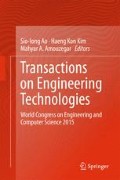Abstract
This article is based on an innovative tool aimed at both recreational games for interactive children and children with attention deficit early, with gesture recognition technology it aims games. The implementation of different games in which there are a variety of activities to make the child learn through play, teaching aid for children’s learning and progress in activities such as coordination, laterality and motor skills and physical inactivity in the most important for the development age, are treated. Finally, the results applied to children is 6 to 8 years old which in their daily activities have little attention and concentration difficult when doing their activities and based on an algorithm of bootstrap results are given to quantify that percentage helps children playful games.
Access this chapter
Tax calculation will be finalised at checkout
Purchases are for personal use only
References
Freire AB, Pazmiño VD, de la Cruz DR, Tobar JB, Mejía PH (2015) Ludic tool that contributes to the physical and motor development based on sensor technology for gesture recognition. In: Lecture notes in engineering and computer science: proceedings of the world congress on engineering and computer science 2015. San Francisco, USA, pp 338–342, 21–23 Oct 2015
Khoshelham K (2012) Accuracy and resolution of kinect depth data for indoor mapping applications. Faculty of geo-information science and earth observation, University of Twente. ISSN: 1424-8220
Dal Mutto C, Zanuttigh Cortelazzo GM (2012) Time-of-flight cameras and microsoft kinect, springer briefs in electrical and computer engineering. Springer, New York
Zeng W (2011) Microsoft kinect sensor and its effect. University of Missouri. Published by the IEEE Computer Society
Tao G, Archambault PS, Levin MF (2013) Evaluation of skeletal tracking in a virtual reality rehabilitation system for upper limb hemiparesis. Interdisciplinary Research Center in Rehabilitation, Laval, Canada
de la Garrido FD (2012) (6 june of, 2012) Kinect applications for neurorehabilitation. Polytechnic University of Catalonia, Thesis work
Patetsianakis E, Ksylakis E, Triantafyllidis G (2014) A kinect-based framework for better user experience in real-time audiovisual content manipulation 2014 international conference on telecomunications and multimedia. Telecom ParisTech, Technological Educational Institute of Crete, Aalborg University
Wenbing Z, Espy DD, Reinthal AM, Feng H (2014) A Feasibility study of using a single kinect sensor for rehabilitation exercises monitoring: a rule based approach. Departament of electrical and computer engineering, Cleveland State University
Ramos C, Bolaños M, Ramos D (2015) Prevalencia del trastorno por déficit de atención con hiperactividad en estudiantes ecuatorianos. Revista científica y tecnológica UPSE, vol III, N 1, pp 13–19 (Dic. 2015)
Mara Cristina Espinoza Salas (2014) Stefanie naranjo oro santacruz. Early Education Curriculum. Ministry of Education
Palou P, Vidal J, Ponseti X, Cantallops J, Borrs PA (2012) Relations between quality of life, physical activity and cardiorespiratory fitness in sedentary children
Solanas A, Sierra V (1995) Boostrap: fundamentos e introducción a sus aplicaciones. Universidad de Barcelona, n 55, pp 143–154
Mooney CZ, Duval RD, Duval R (1993) Bootstrapping: a nonparametric approach to statistical inference. Sage, no 94–95
Hacking the Kinect. Autores: Kramer J, Burrus N, Echtler F, Herrera DC, Y M Parker. Editorial: Technology in Action. Chapter 2: Hardware. Page 13
Andrea C, Edison S, de la Danni C, Mejía P, Paredes (2016) CLEI Electronic J, 19(1), Paper 4, April 2016. http://www.clei.org/cleiej/papers/v19i1p4.pdf
Author information
Authors and Affiliations
Corresponding author
Editor information
Editors and Affiliations
Rights and permissions
Copyright information
© 2017 Springer Nature Singapore Pte Ltd.
About this paper
Cite this paper
Conrado, A.B.F., Moya, V.D.P., De La Cruz, D., Tobar, J., Mejía, P. (2017). Gesture Recognition Sensor: Development of a Tool with Playful Applications to Evaluate the Physical and Cognitive Skills of Children Through the Use of Bootstrap Algorithm. In: Ao, SI., Kim, H., Amouzegar, M. (eds) Transactions on Engineering Technologies. WCECS 2015. Springer, Singapore. https://doi.org/10.1007/978-981-10-2717-8_26
Download citation
DOI: https://doi.org/10.1007/978-981-10-2717-8_26
Published:
Publisher Name: Springer, Singapore
Print ISBN: 978-981-10-2716-1
Online ISBN: 978-981-10-2717-8
eBook Packages: EngineeringEngineering (R0)

